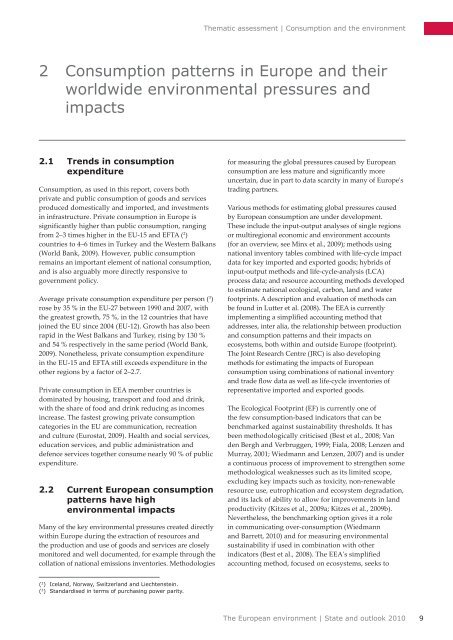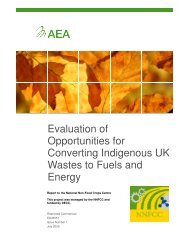Consumption and the environment (SOER2010) - European ...
Consumption and the environment (SOER2010) - European ...
Consumption and the environment (SOER2010) - European ...
You also want an ePaper? Increase the reach of your titles
YUMPU automatically turns print PDFs into web optimized ePapers that Google loves.
Thematic assessment | <strong>Consumption</strong> <strong>and</strong> <strong>the</strong> <strong>environment</strong><br />
2 <strong>Consumption</strong> patterns in Europe <strong>and</strong> <strong>the</strong>ir<br />
worldwide <strong>environment</strong>al pressures <strong>and</strong><br />
impacts<br />
2.1 Trends in consumption<br />
expenditure<br />
<strong>Consumption</strong>, as used in this report, covers both<br />
private <strong>and</strong> public consumption of goods <strong>and</strong> services<br />
produced domestically <strong>and</strong> imported, <strong>and</strong> investments<br />
in infrastructure. Private consumption in Europe is<br />
significantly higher than public consumption, ranging<br />
from 2–3 times higher in <strong>the</strong> EU‐15 <strong>and</strong> EFTA ( 2 )<br />
countries to 4–6 times in Turkey <strong>and</strong> <strong>the</strong> Western Balkans<br />
(World Bank, 2009). However, public consumption<br />
remains an important element of national consumption,<br />
<strong>and</strong> is also arguably more directly responsive to<br />
government policy.<br />
Average private consumption expenditure per person ( 3 )<br />
rose by 35 % in <strong>the</strong> EU‐27 between 1990 <strong>and</strong> 2007, with<br />
<strong>the</strong> greatest growth, 75 %, in <strong>the</strong> 12 countries that have<br />
joined <strong>the</strong> EU since 2004 (EU‐12). Growth has also been<br />
rapid in <strong>the</strong> West Balkans <strong>and</strong> Turkey, rising by 130 %<br />
<strong>and</strong> 54 % respectively in <strong>the</strong> same period (World Bank,<br />
2009). None<strong>the</strong>less, private consumption expenditure<br />
in <strong>the</strong> EU‐15 <strong>and</strong> EFTA still exceeds expenditure in <strong>the</strong><br />
o<strong>the</strong>r regions by a factor of 2–2.7.<br />
Private consumption in EEA member countries is<br />
dominated by housing, transport <strong>and</strong> food <strong>and</strong> drink,<br />
with <strong>the</strong> share of food <strong>and</strong> drink reducing as incomes<br />
increase. The fastest growing private consumption<br />
categories in <strong>the</strong> EU are communication, recreation<br />
<strong>and</strong> culture (Eurostat, 2009). Health <strong>and</strong> social services,<br />
education services, <strong>and</strong> public administration <strong>and</strong><br />
defence services toge<strong>the</strong>r consume nearly 90 % of public<br />
expenditure.<br />
2.2 Current <strong>European</strong> consumption<br />
patterns have high<br />
<strong>environment</strong>al impacts<br />
Many of <strong>the</strong> key <strong>environment</strong>al pressures created directly<br />
within Europe during <strong>the</strong> extraction of resources <strong>and</strong><br />
<strong>the</strong> production <strong>and</strong> use of goods <strong>and</strong> services are closely<br />
monitored <strong>and</strong> well documented, for example through <strong>the</strong><br />
collation of national emissions inventories. Methodologies<br />
for measuring <strong>the</strong> global pressures caused by <strong>European</strong><br />
consumption are less mature <strong>and</strong> significantly more<br />
uncertain, due in part to data scarcity in many of Europe's<br />
trading partners.<br />
Various methods for estimating global pressures caused<br />
by <strong>European</strong> consumption are under development.<br />
These include <strong>the</strong> input-output analyses of single regions<br />
or multiregional economic <strong>and</strong> <strong>environment</strong> accounts<br />
(for an overview, see Minx et al., 2009); methods using<br />
national inventory tables combined with life-cycle impact<br />
data for key imported <strong>and</strong> exported goods; hybrids of<br />
input‐output methods <strong>and</strong> life-cycle-analysis (LCA)<br />
process data; <strong>and</strong> resource accounting methods developed<br />
to estimate national ecological, carbon, l<strong>and</strong> <strong>and</strong> water<br />
footprints. A description <strong>and</strong> evaluation of methods can<br />
be found in Lutter et al. (2008). The EEA is currently<br />
implementing a simplified accounting method that<br />
addresses, inter alia, <strong>the</strong> relationship between production<br />
<strong>and</strong> consumption patterns <strong>and</strong> <strong>the</strong>ir impacts on<br />
ecosystems, both within <strong>and</strong> outside Europe (footprint).<br />
The Joint Research Centre (JRC) is also developing<br />
methods for estimating <strong>the</strong> impacts of <strong>European</strong><br />
consumption using combinations of national inventory<br />
<strong>and</strong> trade flow data as well as life-cycle inventories of<br />
representative imported <strong>and</strong> exported goods.<br />
The Ecological Footprint (EF) is currently one of<br />
<strong>the</strong> few consumption-based indicators that can be<br />
benchmarked against sustainability thresholds. It has<br />
been methodologically criticised (Best et al., 2008; Van<br />
den Bergh <strong>and</strong> Verbruggen, 1999; Fiala, 2008; Lenzen <strong>and</strong><br />
Murray, 2001; Wiedmann <strong>and</strong> Lenzen, 2007) <strong>and</strong> is under<br />
a continuous process of improvement to streng<strong>the</strong>n some<br />
methodological weaknesses such as its limited scope,<br />
excluding key impacts such as toxicity, non‐renewable<br />
resource use, eutrophication <strong>and</strong> ecosystem degradation,<br />
<strong>and</strong> its lack of ability to allow for improvements in l<strong>and</strong><br />
productivity (Kitzes et al., 2009a; Kitzes et al., 2009b).<br />
Never<strong>the</strong>less, <strong>the</strong> benchmarking option gives it a role<br />
in communicating over-consumption (Wiedmann<br />
<strong>and</strong> Barrett, 2010) <strong>and</strong> for measuring <strong>environment</strong>al<br />
sustainability if used in combination with o<strong>the</strong>r<br />
indicators (Best et al., 2008). The EEA's simplified<br />
accounting method, focused on ecosystems, seeks to<br />
( 2 ) Icel<strong>and</strong>, Norway, Switzerl<strong>and</strong> <strong>and</strong> Liechtenstein.<br />
( 3 ) St<strong>and</strong>ardised in terms of purchasing power parity.<br />
The <strong>European</strong> <strong>environment</strong> | State <strong>and</strong> outlook 2010<br />
9








